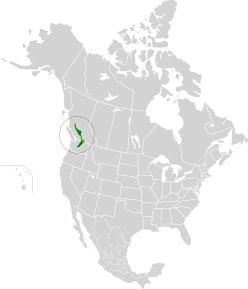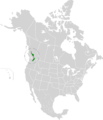Cascade Mountains leeward forests facts for kids
Quick facts for kids Cascade Mountains leeward forests |
|
|---|---|

Stein Valley Nlaka'pamux Heritage Park
|
|
 |
|
| Ecology | |
| Realm | Nearctic |
| Biome | Temperate coniferous forests |
| Borders |
List
|
| Bird species | 187 |
| Mammal species | 81 |
| Geography | |
| Area | 46,300 km2 (17,900 sq mi) |
| Countries | Canada and United States |
| States | British Columbia and Washington |
| Conservation | |
| Conservation status | Relatively Stable/Intact |
| Habitat loss | 67.07% |
| Protected | 43.48% |
The Cascade Mountains leeward forests are a special kind of forest area in North America. It's like a huge natural neighborhood with its own unique plants and animals. The World Wildlife Fund (WWF) helps us understand these important places.
Contents
What are the Cascade Mountains Leeward Forests?
This amazing forest region stretches like a long band. It runs from north to south along the "leeward" side of the Cascade Mountains. "Leeward" means it's on the side that's sheltered from the wind.
Where are these forests located?
You can find these forests in two countries: Canada (in British Columbia) and the United States (in Washington). To the south, near the US-Canada border, is the Okanagan Highland. To the north, you'll find the Chilcotin Ranges.
What is the landscape like?
This area is a mix of rugged, snowy mountain peaks. You'll also see large glaciers and beautiful alpine meadows. It's a truly wild and varied landscape.
What is the weather like?
The temperature changes a lot between seasons. In the southern parts, summer temperatures are around 15°C (59°F). In winter, it drops to about -3.5°C (26°F). The northern parts are usually a bit cooler, by about 2–3°C (4–5°F).
Plants of the Cascade Mountains Leeward Forests
The types of trees change depending on how high up you go on the mountains.
Trees at higher elevations
On the higher subalpine slopes, you'll find certain trees. These include Engelmann spruce (Picea engelmannii). There's also subalpine fir (Abies lasiocarpa) and lodgepole pine (Pinus contorta). These trees are tough and can handle the colder, higher conditions.
Trees at lower elevations
Lower down, in the montane forests, the trees are different. Here, you'll see more lodgepole pine and quaking aspen (Populus tremuloides). White spruce (Picea glauca) and Rocky Mountain Douglas-fir also grow here.
Animals of the Cascade Mountains Leeward Forests
This mountain region is home to many exciting animals.
Large mammals
You might spot large mammals like the bighorn sheep (Ovis canadensis). There are also mountain goats (Oreamnus americanus). Both grizzly bears (Ursus arctos) and black bears (Ursus americanus) live here. Other large animals include black-tailed deer (Odocoileus hemionus), coyotes (Canis latrans), and cougars (Puma concolor couguar).
Smaller creatures and birds
Smaller mammals, like the northern flying squirrel, also call these forests home. For bird watchers, there are spotted owls and dusky grouse (Dendragapus obscurus). Many different birds of prey also soar above the mountains.
The Fraser River's importance
The Fraser River is very important for salmon. It's also a natural barrier that affects how animals move around the region.
Protecting the Cascade Mountains Leeward Forests
Most of these forests are still in their natural state. However, they face some challenges from human activities.
What threatens these forests?
The main threats come from things like logging (cutting down trees) and mining. Other human activities can also disturb the natural environment.
How are these forests protected?
Luckily, many large areas of these forests are protected. This means they are safe from harm. One big protected area is North Cascades National Park in Washington. In British Columbia, there are several important protected places. These include Big Creek Provincial Park and Spruce Lake Protected Area. You'll also find the Stein Valley Nlaka'pamux Heritage Park, E. C. Manning Provincial Park, and Tsʼilʔos Provincial Park. Other protected spots are Cathedral Provincial Park and Protected Area, Skagit Valley Provincial Park, Marble Range Provincial Park, Cascade Recreation Area, and Edge Hills Provincial Park near Fraser Canyon. These parks and protected areas help keep these amazing forests safe for the future.
Images for kids



